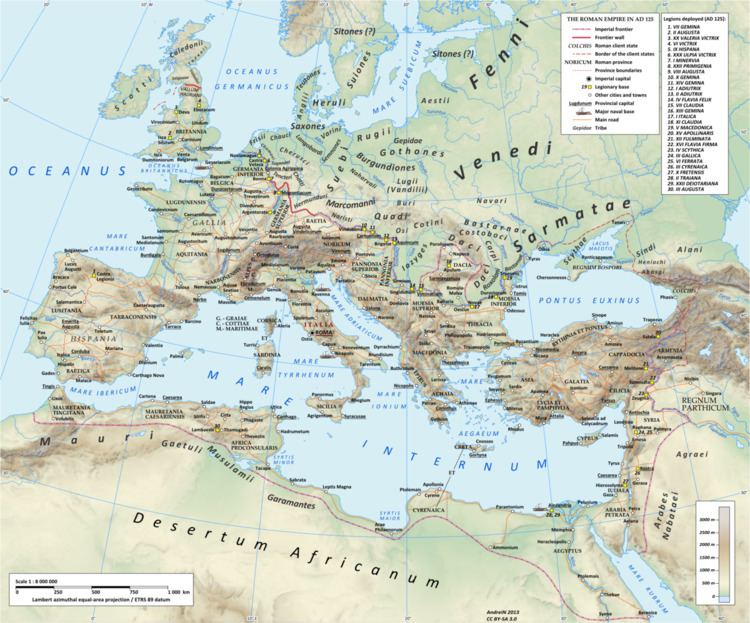 | ||
Active 43 BC to sometime in the 4th century AD Role Infantry assault (some cavalry support) Size Varied over unit lifetime. Approx. 3,500 fighting men + support at the time of creation. Garrison/HQ Hispania Tarraconensis (25 BC - AD 9)Germania (9 - 17)Argentoratum (17-43)Britannia (43-269)Glevum (66-74)Isca Augusta (Caerleon) (74 - c. 208)Carpow (c. 208-c. 235)Isca Augusta (235 - after 255) | ||
Legio secunda Augusta ("Augustus' Second Legion") was a legion of the Imperial Roman army that was founded during the late Roman republic. Its emblems were the Capricornus, Pegasus, Mars, and the second banner from the top left.
Contents
In Republican service
The Legio II Sabina was a Roman military unit of the late Republican era, which may have been formed by Julius Caesar in the year of the consulate of 48 BC and coincide, in this case, with the Legio II . Enlisted to fight against Pompey, they took part in the subsequent battle of Munda of 45 BC.
Alternatively it could be the Legio II, formed by the consul, Gaio Vibio Pansa in 43 BC and recruited in Sabina, hence its nickname. It might have participated in the subsequent battle of Philippi of 42 BC on the side of the triumvirate, Octavian and Marc Antony.
After the defeat of the Republicans, Legio II swore allegiance to Octavian and with the same remained until the battle of Actium of 31 BC, after which it seems to have been dissolved in the years between 30 and 14 BC (sent on leave were between 105,000 and 120,000 veterans and some of its soldiers may have been integrated into the new Legio II Augusta.
In Imperial service
At the beginning of Augustus' rule, in 25 BC, this legion was relocated in Hispania, to fight in the Cantabrian Wars, which definitively established Roman power in Hispania, and later camped in Hispania Tarraconensis. With the annihilation of Legio XVII, XVIII and XIX in the Battle of the Teutoburg Forest (AD 9), II Augusta moved to Germania, possibly in the area of Moguntiacum. After 17, it was at Argentoratum (modern Strasbourg).
Invasion of Britannia
The legion participated in the Roman conquest of Britain in 43. Future emperor Vespasian was the legion's commander at the time, and led the campaign against the Durotriges and Dumnonii tribes. Although it was recorded as suffering a defeat at the hands of the Silures in 52, the II Augusta proved to be one of the best legions, even after its disgrace during the uprising of queen Boudica, when its praefectus castrorum, who was then its acting commander (its legatus and tribunes probably being absent with the governor Suetonius Paulinus), contravened Suetonius' orders to join him and so later committed suicide.
After the defeat of Boudica, the legion was dispersed over several bases; from 66 to around 74 it was stationed at Glevum (modern Gloucester), and then moved to Isca Augusta (modern Caerleon), building a stone fortress that the soldiers occupied until the end of the 3rd century. The legion also had connections with the camp at Alchester in Oxfordshire; stamped tiles record it in the 2nd century at Abonae (Sea Mills, Bristol) on the tidal shore of the Avon (Princeton Encyclopedia).
2nd and 3rd centuries
In 122, II Augusta helped to build Hadrian's Wall.
In 142, II Augusta helped to build the Antonine Wall and are recorded on The Bridgeness Slab.
In 196, II Augusta supported the claim for the purple of the governor of Britannia, Clodius Albinus, who was defeated by Septimius Severus. On the occasion of Severus' Scottish campaign, the Second moved to Carpow, to return to Caerleon under Alexander Severus.
